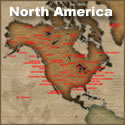Haida Tattoos
British Columbia and Washington StateThe Haida were the most accomplished of all
North American native artists and craftsmen. Their totem poles, canoes, and
dwellings were embellished with traditional designs associated with mythical and
totemic themes.
|
|
James G. Swan wrote the only scholarly first-hand account of native tattooing
in North America. He felt that natives should be considered worthy of respect
and he wrote accounts of their rapidly vanishing culture in Pacific Northwest
which was published in 1857.
|
In 1874, Swan's monograph,
The Haida Indians of Queen Charlotte's Islands,
British Columbia was published by the Smithsonian Institution and in
1878, Tattoo Marks of the Haida appeared. Swan had hoped to get government money to
further study native tattooing but the government refused to fund the project.
In Swan's Tattoo Marks of the Haida, he wrote:
In February 1879 I was fortunate enough to meet a party of Haida men and women
in Port Townsend, Washington, who permitted me to copy their tattoo marks. The
tattoo marks of the Haida are heraldic designs of the family totem, or crests of
the wearers, and are similar to the carvings depicted on the pillars and
monuments around the homes of the chiefs. … These designs are invariably placed
on the men between the shoulders just below the back of the neck, on the breast,
on the front part of both thighs, and on the legs just below the knees. On the
women they are marked on the breast, on both shoulders, on both forearms, from
the elbow down over the back of the hands to the knuckles, and on both legs
below the knee to the ankle.
Almost all the Indian women of the northwest
coast have tattoo marks on their hands and arms, and some on the face; but as a
general thing these marks are mere dots or straight lines having no particular
significance. With the Haidas, every mark has its meaning; those on the hands
and arms of the women indicate the family name, whether they belong to the bear,
beaver, wolf or eagle totems, or any of the family of the fishes.
Certain ones, almost always men, have a natural gift which enables them to
excel in this kind of work. One of young chiefs, named Geneskelos, was the best
designer I knew, and ranked among his tribe as a tattooer.
He told me the plan he adopted was first to draw the design carefully on the
person with some dark pigment, then prick it in with needles, and then rub over
the wound with some more coloring matter till it acquired the proper hue.
Haida Tattoo Instruments
He had a variety of instruments composed of needles tied neatly to sticks. His
favorite one was a flat strip of ivory or bone, to which he had firmly tied five
or six needles, with their points projecting beyond the end just far enough to
raise the skin without inflicting a dangerous wound, but these needle points
stuck out quite sufficiently to make the operation very painful, and although he
applied some substance to deaden the sensation to the skin, yet the effect was
on some to make them quite sick for a few day; consequently, the whole process
of tattooing was not done at one time.
Tattoo Museum Bibliography, Resources and Links
 See all North American Tattoo Culture Articles here
See all North American Tattoo Culture Articles here
See these articles:
Crest Tattoos of the Tlingit and Haida of the Northwest Coast,
"Haida Tattoo Kit" collected by ethnologist James G. Swan
and Early Haida Tattoo History/Photos
for more information about tattoos and tattooing among the Haida.
NEXT >>
Arctic & Alaska
